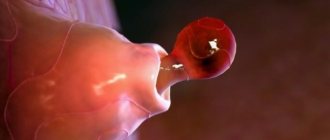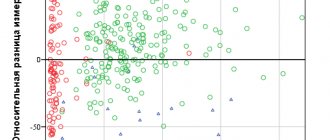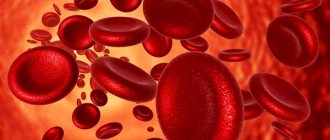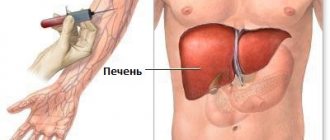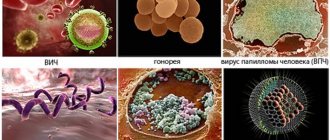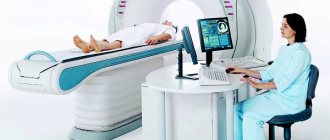Reasons for increased PSA
An increase in PSA occurs with an increase in the size of the prostate (due to benign hyperplasia), inflammation (prostatitis) and a tumor process. Please note that mechanical stimulation of the prostate gland also leads to an increase in PSA (prostate massage, digital rectal examination or TRUS of the prostate), so after these procedures you must wait at least 10 days before taking a blood test for PSA .
It is equally important to know that some drugs for the treatment of prostate adenoma (finasteride, dutasteride, Proscar, penester, avodart and their analogues) lower the PSA level by 50%, that is, if you are taking these drugs, then your analysis is necessary to adequately interpret the result PSA blood test multiplied by two. The main role of PSA as a tumor marker is that it allows one to SUSPECT prostate cancer at an early stage.
Prostate-specific antigen total (PSA total)
General prostate-specific antigen is the amount in the blood of fractions of a substance that is part of the secretion of the prostate gland, serine protease, that is accessible for determination. Prostate-specific antigen is a laboratory marker of the condition of prostate tissue.
Synonyms Russian
Prostate specific antigen is a common marker of prostate cancer.
English synonyms
Prostate-specific antigen total, PSA total.
Research method
Chemiluminescent immunoassay.
Units
ng/ml (nanograms per milliliter).
What biomaterial can be used for research?
Venous blood.
How to properly prepare for research?
- Eliminate fatty foods from your diet 24 hours before the test.
- Avoid physical and emotional stress for 30 minutes before the test.
- Do not smoke for 30 minutes before donating blood.
- After prostate massage, at least 10 days must pass before analysis.
General information about the study
Prostate-specific antigen (PSA) is a protein substance, an enzyme related to serine proteases. This is one of the products of prostate synthesis.
The prostate gland consists of muscle tissue and a large number (about 50) of small glands. Muscle tissue is designed to move the fluid that the prostate produces into the internal ducts towards the lumen of the urethra. In addition, intense contractions of the prostate muscles ensure the process of ejaculation during sexual intercourse.
The prostate glands produce prostate secretion, which has several functions: it is part of the seminal fluid and serves as an important component of the nutrient medium for sperm. This is a complex composition of biologically active substances that ensure the vital activity of male germ cells. A small part of the secretion enters the blood and performs a complex hormonal function - ensures the normal functioning of the testicles, bladder function, regulates sexual desire, affects blood circulation, nervous processes and mental state.
One of the components of prostate secretion is PSA. According to its chemical structure, it is a glycoprotein - a combination of protein and carbohydrates; according to its biochemical properties, it is an enzyme that performs the function of splitting large protein molecules into smaller fragments. Thanks to this ability, it dilutes the seminal fluid. Along with that part of the prostate secretion that enters the systemic bloodstream, a small portion of the prostate-specific antigen produced by the prostate also penetrates there. The function of prostate-specific antigen in the body is unknown, but in laboratory diagnostics it is used to identify prostate diseases. Some of its fractions have antigenic properties, which makes it possible to identify them using immunochemical laboratory methods. The combination of these properties determined the name for this substance as “prostate-specific antigen.”
In serum, PSA exists in several forms. Two of them are available for determination by immunochemical methods:
1) bound prostate-specific antigen - is in a chemical connection with another compound that blocks its enzymatic function (alpha-1-antichymotrypsin),
2) free prostate-specific antigen – remains in a free (unbound) state.
Together they reflect the level of total prostate-specific antigen.
Small fluctuations in the value of total PSA are closely related to both changes in the functioning of the prostate gland, which are not pathologies, and to various prostate diseases. For example, PSA levels are affected by individual differences in prostate weight: a larger prostate produces, accordingly, more PSA. In addition, the age of the patients matters: the amount of PSA gradually increases throughout life. Mechanical effects on the prostate gland, such as massage or cycling, can also cause an increase in this indicator. Ejaculation has the same effect.
Total PSA increases moderately with prostate hypertrophy (adenoma), acute and chronic inflammatory diseases of the prostate gland (prostatitis), and urinary tract infections, but the main diagnostic value of this analysis is the timely detection of prostate cancer.
Prostate cancer is one of the most common cancers in men. This disease is especially common in men over 50 years of age. In Russia, in almost 70% of patients it is detected only at the 3rd-4th stage. Meanwhile, if prostate cancer is detected early, the effectiveness of its treatment is very high. But, unfortunately, in the early stages this disease is asymptomatic. In this regard, upon initial contact with an oncologist, 70% of patients already have tumor spread to surrounding tissues or distant organs. This is why it is so important for men to get a PSA test periodically. Classic methods for detecting prostate cancer - palpation of the prostate gland through the rectal wall in combination with ultrasound - have limited sensitivity and often do not allow timely detection of the tumor, while the PSA test makes it possible to diagnose even early, asymptomatic forms of the disease.
An increase in PSA levels at the beginning of the disease occurs as a result of impaired function of prostate cells and increased permeability of blood vessels, which stimulates the release of specific substances from prostate cells into the extracellular environment. Tumor cells themselves synthesize prostate-specific antigen in smaller quantities than normal tissues. Thus, this test is highly specific for prostate tissue, but not for prostate tumors. However, as the total mass of tumor cells increases, their share in the production of prostate-specific antigen increases, having an increasing impact on the results of laboratory analysis.
The higher the PSA level in the blood, the more confident we can speak about the presence of a malignant process in the prostate gland. However, if total PSA is slightly elevated, the reliability of the diagnosis is questionable, since the same result can be obtained with other prostate diseases, such as benign hypertrophy or prostatitis.
The sensitivity of the PSA indicator increases significantly with simultaneous analysis of the total and free fractions of this substance in the blood and determining the ratio of the results obtained. The proportion of free PSA in the blood serum in prostate cancer is significantly lower than its level in any benign process. Due to this, a more accurate distinction between benign and malignant prostate diseases is possible with a minimal increase in total PSA.
Early diagnosis of prostate cancer is also carried out through an annual preventive examination. An excessive increase in PSA levels over a year indicates an increased risk of developing the disease.
The total PSA test is also used in the treatment of prostate cancer. This indicator is used to judge the success of therapy: a significant decrease in PSA levels indicates a positive result of treatment measures. This analysis is very important for the timely detection of relapse of the disease after surgical treatment.
What is the research used for?
- For early diagnosis of adenoma and inflammatory diseases of the prostate gland.
- For the diagnosis of ischemia or infarction of the prostate gland.
- For early diagnosis of prostate cancer.
- For differential diagnosis of prostate cancer and its benign diseases, as well as infectious and inflammatory processes of the urinary tract.
- To evaluate the effectiveness of drug therapy for prostate cancer.
- To monitor the results of surgical treatment of prostate cancer.
- For timely diagnosis of recurrent prostate cancer after surgical treatment.
- As part of a preventive examination for the early diagnosis of benign diseases and prostate cancer.
When is the study scheduled?
- For symptoms of prostate disease:
- increased frequency of urination,
&l
What do the results mean?
Reference values: 0 - 4 ng/ml.
The amount of total PSA may increase modestly in some conditions not associated with prostate disease, as well as in a number of pathological conditions. The degree of increase in its level is directly proportional to the severity of prostate disease. A low total PSA level indicates a low risk of prostate disease or the success of treatment.
Reasons for increased total PSA levels:
- relative increase in prostate mass,
- prostate massage / cycling / ejaculation less than 24 hours before the test,
- infection/inflammatory process of the urinary tract,
- prostate adenoma,
- prostatitis,
- ischemia/infarction of the prostate gland,
- prostate cancer.
Reasons for low total PSA levels:
- low risk of developing prostate disease,
- successful treatment of prostate disease.
Important Notes
- A negative test result does not exclude the presence of prostate disease.
- Different laboratories may use different analysis methods, so the results are not always the same. In this regard, repeated tests are recommended to be carried out in the same laboratory in which the initial study was carried out.
Also recommended
- Carcinoembryonic antigen (CEA)
Who orders the study?
General practitioner, therapist, urologist, oncologist, surgeon.
Literature
- Andriole GL, Crawford ED, Grubb RL, et al. Mortality results from a randomized prostate-cancer screening trial. N Engl J Med 2009;360:1310–9.
- Schroder FH, Hugosson J, Roobol MJ, et al. Screening and prostate-cancer mortality in a randomized European study. N Engl J Med 2009;360:1320–8.
- Osterling JE, Jacobsen SJ, Chute CG, et al. Serum prostate-specific antigen in a community-based population of healthy men: establishment of age-specific reference ranges. JAMA 1993;270:860–4.
- Carter HB, Pearson JD, Metter EJ, et al. Longitudinal evaluation of prostate-specific antigen levels in men with and without prostate disease. JAMA 1992;267:2215–20.
- Beduschi MC, Osterling JE. Percent free prostate specific antigen: the next frontier in prostate-specific antigen testing. Urology 1998;51(Suppl 5A):98–109.
- Modi P, Helfand BT, McVary KT. Modifications and surgical interventions for benign prostatic hyperplasia are potential confounders of prostate-specific antigen. Curr Urol Rep 2010;11:224–7.
- Gleason DF. Histologic grading and staging of prostatic carcinoma. In: Urologic Pathology: The Prostate. Philadelphia, Lea and Febiger 1977, p. 171–8.
- Oesterling J.E. Using PSA to eliminate unnecessary diagnostic tests: significant worldwide economic implications. Urology 1995;46(Suppl 3A):26–33.
- Mitchell DM, Swindell R, Elliott T, Wylie JP, Taylor CM, Logue JP. Analysis of prostate-specific bounceafter I(125) permanent seed implant for localized prostate cancer. Radiother Oncol 2008;88:102–7.
Interpretation of the PSA blood test
The specificity of a general blood test for PSA increases if, along with its total level, the free fraction is determined. The ratio of free PSA/total PSA > 15% is more typical for benign hyperplasia, < 15% is alarming for oncology. To clarify the diagnosis, a puncture biopsy of the prostate gland is performed.
Research in recent years has brought significant changes to the concept of early diagnosis of prostate cancer based on PSA. First, it has been shown that there is no absolutely safe PSA level that can completely rule out the possibility of cancer.
Secondly, new tumor markers have appeared and become widespread (including approval by regulatory authorities in the USA, European countries and Russia), of which [-2]pro-PSA (or pro-PSA is an isoform of PSA) and PCA are of greatest interest -3 (Prostate Cancer Antigen, prostatic cancer antigen, is currently just beginning to be used in Russia).
The definition of [-2]pro-PSA allows you to calculate the so-called “Prostate Health Index” (PHI) using the formula PHI=[-2]pro-PSA/free PSA*√totalPSA. According to a 2011 American study led by WJ Catalona, a PHI value of less than 24.9 indicates a low risk of prostate cancer (less than 11%), PHI intervals from 25 to 34.9 and from 35 to 54.9 are associated with a risk of prostate cancer of 18.1 % and 32.7%, respectively, and with higher Prostate Health Index (PHI) numbers, the probability of detecting prostate cancer on biopsy is 55%.
The value of the Prostate Health Index (PHI) is that it refines the indication for prostate biopsy in the range of 2 to 10 ng/mL, reducing the number of “unnecessary” biopsies and increasing the detection of clinically significant prostate cancer.
Prostate cancer antigen (PCA-3) is a tumor marker that allows you to suspect prostate cancer using a urine test . Determination of PCA-3 in urine is a fairly sensitive method for the early diagnosis of prostate cancer. Unlike PSA, PCA-3 levels do not depend on prostate volume. In Russia, urine testing for PCA-3 is not yet publicly available.
The current EAU Guidelines suggest using a prostate cancer risk calculator to individually assess risk and decide whether a prostate biopsy is necessary for patients with a PSA level between 2 and 10 ng/mL.
The most common prostate cancer risk calculator is available at: https://riskcalc.org/PCPTRC/
The program will prompt you to enter the following parameters: race (African-American/Caucasian/Hispanic/other), age (from 55 to 90 years), total PSA level (ng/ml), heredity for prostate cancer (yes/no/not known), data from digital rectal examination (there are deviations/no deviations/not performed), data on previously performed prostate biopsy (not performed/was performed - the result is negative/was performed - the result is unknown). In addition, it is possible (and desirable) to enter the percentage of free/total PSA.
Your individual risk of detecting prostate cancer on prostate biopsy will then be determined. The result is presented graphically as green (no cancer), yellow (non-aggressive prostate cancer) and red (aggressive prostate cancer) symbols.
There are other prostate cancer risk calculators available online.
So, when is a prostate biopsy necessary? For any suspicion of prostate cancer. Indications for performing a puncture biopsy of the prostate gland (Campbell-Walsh Urology, 10th edition, Saunders, USA, 2012):
- An increase in PSA > 4.0 ng/ml in men of any age.
- An increase in PSA > 2.5 ng/ml in men under 60 years of age.
- PSA increase > 0.6 ng/ml in men aged 40 years and younger.
- PSA increase is more than 0.75 ng/ml per year.
- The presence of compactions or suspicious focal changes during a digital rectal (urological) examination or TRUS - regardless of PSA level .
Blood norm
Results of 0-4.0 ng/ml will be good. Doctors say that men over forty years old need to have levels of 2.5, and over fifty years old – about 3.5 ng/ml. Have your body examined regularly by specialists, especially if you are over 40 years old.
Both high and low changes in PSA levels of a constant nature can be caused by an infectious process in the prostate or its adenoma. Pressure on the prostate temporarily raises PSA levels. However, if it is consistently at a high level, doctors most often associate it with cancer, which requires in-depth medical analysis and prompt medical intervention.
| Brief price list for tests | |
| Calling a nurse to your home | 1500 rubles |
| Doctor's appointment at the clinic | 900 rubles |
| Collection of biomaterial | 200 rubles |
| Intramuscular injections | 200 rubles |
| Blood tests for hCG | 600 rubles |
This article does not constitute medical advice and should not serve as a substitute for consultation with a physician.
How is a prostate biopsy performed?
Prostate biopsy procedure
A puncture biopsy of the prostate gland is a minimally invasive diagnostic procedure, during which several filamentous columns are removed from the prostate gland using a special automatic device under ultrasound control for subsequent histological examination.
The standard puncture biopsy technique involves obtaining 12 cores (six from each lobe of the prostate gland). I use an atraumatic transrectal approach, in which an ultrasound probe along with a channel for a biopsy needle is inserted through the rectum.
How to do a prostate biopsy
Since in this part of the rectum, as well as in the prostate gland, there are practically no pain receptors, the prostate biopsy is almost painless, accompanied only by “clicking” sensations.
At the same time, at your request, it is possible to perform a prostate biopsy “in your sleep” , using absolutely safe ultra-short-acting drugs.
After a prostate biopsy, in the rectum , which is removed independently within a day. You are observed in the day hospital ward for an hour and, after a follow-up examination, leave the clinic.
Preparing for a biopsy
Despite its simplicity, preparation and standard preoperative examination are required to perform a prostate biopsy safely.
It is possible to perform a biopsy immediately on the day of the consultation , but to do this, contact me in advance and send the test results and examination by email. The introduction of PSA blood testing into clinical practice has led to the fact that we practically no longer see advanced incurable forms of prostate cancer, and early diagnosis allows us to completely cure this disease!
Don't forget to donate blood annually for PSA ( complete blood test for PSA )! Be healthy!
Questions about the article
.Sergey Mikhalev
April 29, 2021 at 08:40
Hello. I am 35 years old. a couple of weeks ago, discomfort appeared when urinating. The TAM contained bacteria, leukocytes, hemoglobin, platelets and mucus. Prescribed antibiotics Manural as prescribed by the doctor, and everything went away. The discomfort and pain went away, and then they sent me for a PSA test. According to the results of the analysis, Psa total - 5.02, PSA total/psa free - 9.96, PSA Free - 0.5. Does this mean that I have cancer, and what procedures need to be completed to confirm or exclude this diagnosis?
Anton Evgenievich Rotov
April 29, 2021 at 05:38 pm
The increase in PSA in your case is most likely due to inflammation in the prostate - prostatitis. Just retake the test 2-3 weeks after the inflammation has subsided
Ruslan, 41 years old
December 14, 2021 at 04:26 pm
Hello, Doctor! Several years ago, 10 years ago, I was treated for chronic prostatitis. In 2021, I took PSA tests. Total PSA = 0.335 ng/ml, free PSA = 0.130 ng/ml, Free PSA/total PSA ratio = 38.81% I recently took PSA tests. Total PSA = 0.349 ng/ml, free PSA = 0.080 ng/ml, free PSA/total PSA ratio = 22.92%. The reference values of the laboratory service indicate that the norm is from 25% to 100%. Please tell me if there is any cause for concern? Thank you.
Anton Evgenievich Rotov
December 16, 2021 at 04:55 pm
Everything is fine, there is no reason to worry
Altats
September 4, 2021 at 09:55 pm
Hello!!! My father had an operation, but the dog’s level after the test shows 1.6. Is this result normal or what? He takes medications and hormones prescribed by his doctor regularly.
THIS is normal
Anton Evgenievich Rotov
September 4, 2021 at 10:08 pm
It depends on what kind of operation we are talking about. If we talk about radical prostatectomy, then this is too much. It is better to discuss this with an oncologist (if the diagnosis is oncological)
Contact a specialist
It is not difficult to undergo PSA tests in Moscow. To do this, men will have to find a qualified specialist who has extensive experience. The cost of a PSA test will be low, so the examination can be completed without a large budget. As a result, the man will know whether he has any diseases, and he will be able to take further measures.
Today, many clinics offer PSA testing, the price of which is low. It is worth considering that this procedure is necessary not only in the presence of symptoms of the disease. A man must independently decide to undergo a PSA test in Moscow.
Many clinics offer a PSA test service, the price of which will be low. The results obtained will be used to make an accurate diagnosis and create a treatment plan. Thanks to PSA analysis data, it is possible to determine which measures will be most effective in treating a particular disease. Do your research and take charge of your health.
